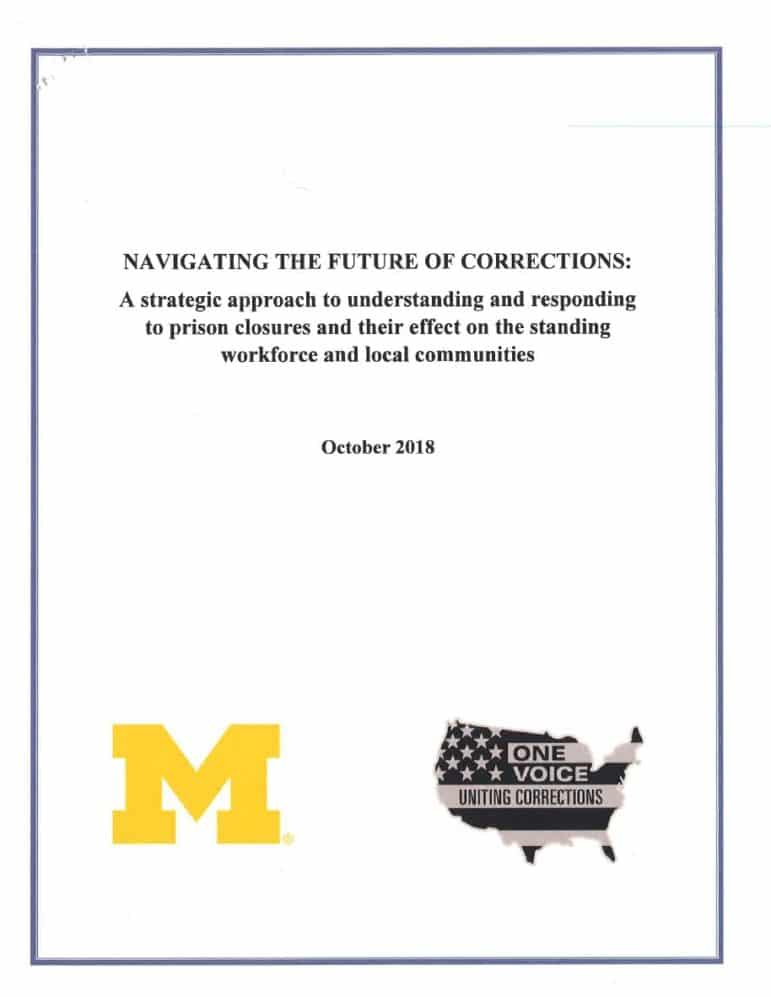A Strategic Approach to Understanding and Responding to Prison Closures and Their Effect on The Standing Workforce and Local Communities
Executive Summary
Criminal justice in the U.S. is at an inflection point. Inmate populations are in decline due to lower crime rates and a state retreat from the “tough on crime” policies that began in the 1970s. Consequently, prisons are being shuttered and prison personnel are facing the threat of layoff. The intent of this report is to present analyses to assist stakeholders in managing this contracting sector of the economy. The context is Michigan, however many conclusions can be broadly generalized to other states.
The first section of the report traces Michigan’s inmate population growth beginning in the late 1970s and extending through the first years of the new millennium. During the early rapid growth period the prison capacity was insufficient, requiring the Michigan Department of Corrections (MDOC) to erect temporary housing and construct permanent facilities. The “capacity crisis” ended around the mid-1990s when the design capacity caught up with the inmate population. Since then, the MDOC has maintained an inmate to design capacity ratio in the range of 1.0 to 0.95. A trend analysis indicates that facility closures are observable when this ratio falls at or below 0.95.
Unlike facility space, personnel hiring has not kept pace with inmate population growth. The inmate to officer ratio was about 4 to 1 in the mid-1980s, and it is now 6.6 to 1. The per capita reduction of officers has not been offset with an increase in non-officer staff. The inmate to employee (i.e. officers plus other staff) ratio has increased from 2.5 to 1 to 4.1 to 1; an identical increase when considering just the officers. Implications for the mission of custody, security and rehabilitation, along with issues like personnel and inmate safety and worker stress, deserve attention.
The second section assesses the economic contribution of the MDOC system on local economies as measured by jobs and personal income. Using an advanced input-out model, two analyses are performed. First, an economic effect is estimated for each Michigan county. Unsurprisingly, counties that are home to MDOC prison facilities are the prime beneficiaries of MDOC spending. Of these, the rural counties tend to be the most reliant on MDOC for both jobs and income. In terms of economic dependency, the top five Michigan counties are: Luce, Baraga, Alger, Chippewa and Ionia.
A related analysis ranks each facility in terms of its economic contribution to the region, where region is defined as a four-county area. This second analysis assessed each facility in terms of jobs, income and population. Larger facilities make a greater contribution to a region, and once again, those facilities situated in rural counties have a comparably larger role in the regional economy.
The third and final section of the report involved a survey of states that had experienced a decline in inmate populations to determine what policies were responsible, and how these policies have affected the occupational composition of the criminal justice system. The intent was to understand major policy trends that might threaten officer employment and discover potential career pathways for personnel displaced through facility closures.
Five policy areas were identified: local and state realignment, reentry programming, bail reform, problem-solving courts and technology. Each policy can independently affect the size of the state inmate population or demand for officers. Local and state realignment entails shifting the custody, security and rehabilitation responsibility from state prisons to local municipal jails. Reentry programming aims to minimize recidivism. Bail reform creates excess capacity at local jails, which in tum can be used to supplement state prison capacity. Problem-solving courts direct qualified offenders to treatment, for issues like drug and alcohol addiction, as an alternative to incarceration. And technology potentially reduces the level of facility staffing through modern methods of surveillance and control.
While these policies may threaten the job security of officers, they might also present opportunities within the prison environment and in the broader criminal justice system. For instance, reducing recidivism through a comprehensive reentry program will likely create a demand for educators, vocational trainers, councilors, social workers, and so forth, both within the prison and with external service providers. This report identifies occupations that are likely to grow due to the aforementioned policies. Given their understanding of inmates and knowledge of prison protocol, corrections officers that are trained in these emergent areas should be highly qualified candidates for these jobs.
A well-designed education and placement program can prepare officers for new roles, and facilitate the transition of displaced workers into other areas of the larger criminal justice system. State subsidies for officers to encourage the pursuit of supplementary education, coupled with referral assistance or transfer rights, can serve all stakeholders. Officers benefit from the opportunity for career growth; the employer benefits from a better trained and productive workforce; inmates are served by a more professional staff, and the criminal justice system as a whole is enhanced by creating a pool of talent that can be deployed for any future policy adjustment or contingency.
In sum, criminal justice systems across the United States are evolving by moving away from incarceration as a solution to crime. These policy changes, should they progress, will result in prison facility closures and layoffs for prison personnel. In Michigan, a major facility was closed in 20 I 6, two others in 2018, and another closure announcement was made in August, 2018; all due to declining inmate populations. Ethics holds that because the states were responsible for the rapid expansion of this sector, the states also have an obligation to the career personnel and communities negatively affected by the sectoral decline. It is our hope that this report serves as a useful resource for stakeholders that want to anticipate the effects of these policies, and mitigate against any negative repercussions for communities and employees.

